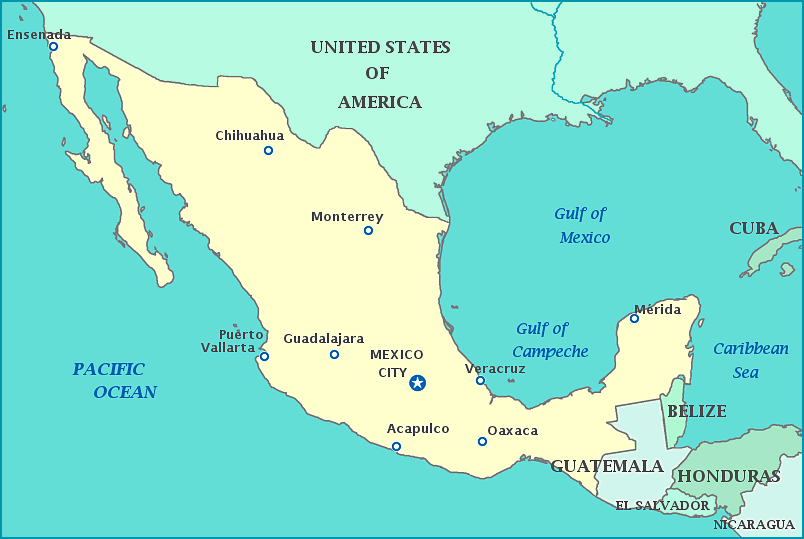
Print this map of Mexico US States and Capitals Map Quiz
Free Maps, Map Puzzles and Educational Software: Owl and Mouse Educational Software
Mexico
The United Mexican States, or Estados Unidos Mexicanos properly, is the most populous Spanish speaking country in the world and the second-most populous country in Latin America. It was the heart of the Aztec empire. The Olmec, Toltec, Teotihuacan, Zapotec, and the Maya inhabited the land as far back as 10,000 years.
The main empire was the Aztec empire, which demanded supreme authority and tribute from others instead of outright conquering its foes. Tribute was in the form of human lives, as the Aztecs were infamous for sacrificing hundreds of people at a time. This practice was embedded in Aztec culture to the point that Aztec warriors did their best not to kill their enemies, but to capture them alive for sacrifice.
The land of Mexico was discovered by Europeans in 1518 by Juan De Grijalva, who sent back tales of gold and jewels, as well as bloodthirsty warriors. The next year, Hernan Cortez was sent to conquer the natural wealth of Mexico and its people. Cortez took advantage of not only a feud over power succession, but also the Aztec's reluctance to kill and the hatred for them by those they had conquered. During the invasion, emperor Moctezuma II, the last emperor of the Aztecs, was ransomed off for an entire room full of gold, only be executed later by Cortez's forces shortly after his brother Cuitlahuac died of smallpox. Thousands followed him to death from the diseases the Spanish had brought with them, an unintentional and highly successful attack that aided conquest of the New World more than firearms.
Somewhere between 3 to 15 million people were dying from disease and the royal family were dead, yet it would be two centuries later that the Aztec empire was finally conquered. From what is now New Mexico to Costa Rica—as well as most of the Caribbean, Florida, and the Philippines—was claimed as New Spain in 1521. Many smaller groups of other natives remained and were amalgamated into the new empire; this fusion of native and Spanish culture in the colonial period eventually formed the iconic and unique culture of Mexico. Not all amalgamation was peaceful, as there were resistances, uprisings, and the Tepehuan Revolt in 1616, lasting until 1620. Mexico was the first in the Americas to establish a printing house, primary school, and university. (There was a university in Mexico when the Pilgrims landed in New England.)
Despite Spain's eagerness for gold, the country became the leading silver producer and remains so today. So much silver was produced that Mexico was soon providing over half New Spain's taxes, especially since growing grapes or olives was discouraged in the name of not competing with those back in the mother country. Foreign trade was also stifled as only two ports were open to foreign traders—Vera Cruz on the Atlantic coast and Acapulco on the Pacific coast—and they were both mainly used for moving exports to Spain and its trading partners. Leaving only one port on each side open to trade with other countries was meant to deter English and Dutch pirates; this was highly ineffective, as these and other ports were attacked, plundered, burned, and ravaged often.
Eventually, anti-Spanish sentiment began to grow for many reasons inspired by prejudice, including higher offices being banned for both natives and whites born in the new country. In 1810 a 'loyalist movement' against the junta ruling New Spain was declared by priest Miguel Hidalgo Y Costilla. When Hidalgo and his followers were executed in 1811, the movement was taken over by Jose Maria Morelos, who was also executed in 1815. Before his death, Acta Solemne de la Declaracion de Independencia de la America Septentiriona (Solemn Act of North American Declaration of Independence was signed in 1813, spuring on the inevitable revolution. Official independence of the 'Mexican Empire' was declared in 1821 and Augustin, hero and leader of the revolution, declared himself emperor. Mexico's declaration started a chain reaction of the rest of Spain's Central American territories declaring themselves independent from both Spain and Mexico itself.
The Empire of Mexico did not last long, as two years later, a revolt ousted Augustin and in 1824, the country became a republic. 1824 also saw the constitution rescinded and a civil war in response. During the civil war, both the Republic of Texas—which included territory that would eventually include the US states of Texas, New Mexico, Arizona, and other states—seceded and joined the US as well as the Yucatan; both declared independence from Mexico. No effort had been made to settle North America other than Florida until 1598, yet the Republic was half of Mexico's territory. Mexico tried to retake the land in 1846, expecting a small and short skirmish, only to begin the Mexican-American War. After two years, Mexico had to cede the land to the US and focus on the Yucatan
The caste system had taken land and rights from criollos, indios, mestizos and especially full-blooded Mayans, who outnumbered all other groups 3 to 1, but only worked the land under harsh and cruel conditions. With the help of Santiago Iman, the Mayans declared themselves and the land of the Yucatan independent from Mexican laws and rule while the government was fighting for Texas. The Mexican government refused to accept the declaration and established a blockade to prevent supplies and weapons from getting to the Mayans. In an attempt to prevent a violent Mayan revolt, Mendez, the then president of Mexico, had many Mayan leaders executed, the city of Tepich burned, and several cities sacked. This only bolstered Mayan determination and Cecillio Chi, the leader of the Tepich Mayans oredered all non-Maya in Maya cities executed. While the Maya held most of the Yucatan after their retaliation, they fought a losing battle. More and more land was taken by Mexico despite many overseas countries siding with the Maya, and the Yucatan was officially returned to Mexico in 1848, though fighting continued for almost fifty years. The town of Ixcanha managed to negotiate more weapons and a ceasefire and enjoyed independence until 1891 The UK recognized the Maya as the rulers of the Yucatan until 1855, when lack of trade with Mexico began to hurt their overseas economy. With the lack of British trade, Mayans no longer had a source for weapons and the last Mayan city was retaken by Mexico in 1901. Still, the Caste War of the Yucatan is known as the most successful modern native revolt in the Americas and rebels who survived the war maintained nearly autonomous enclaves until the 1930's.
Until 1980, Mexico was a poor and struggling country despite its silver mines and plantations. Attempts to fix the economy led to inflation and so many other disasters that the Mexican economy collapsed in 1994. Thanks to the US president Bill Clinton, the US aided Mexico's economy to recover without international intervention and Mexico could finally compete with other modern countries with worldwide trade. Today it is the largest producer of automobiles in the world and the second largest exporter of electronics to the US. It is also the most visited country by tourists in the world.
Mexico is the 14th largest country in the world. Even with two mountain ranges running through it, the Sierra Madre Oriental and the Sierra Madre Occidental, which are both extensions of the Rockies in the US, the country is mostly dry lowlands which see rain often from hurricanes in the winter and summer. It is considered a megadiverse country with over 200,000 species unique to the country. It is the second leading country in diverse ecosystems and 4th in the number of species that call it home. Most of the population claims to be Mestizo, but the government insists the terms is a cultural definition and not a racial one, and instead promotes the term 'Ladino'. Sadly, it also sees the second greatest rate of deforestation in the world as of 2002. The country is also infamous for crime and corruption rates are so high, citizens find reporting crimes to the police useless; which makes it no surprise that it ranks 16th in homicides against women.
Area: 1,964,375 square kilometers
Population: 121,736,809 (2015)


